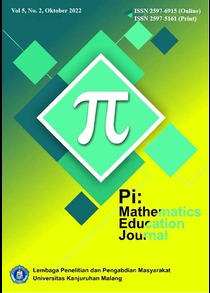KEMAMPUAN KONEKSI MATEMATIKA SISWA BERDASARKAN JENIS KELAMIN
Abstract
Tujuan penelitian ini adalah untuk mendeskripsikan kemampuan koneksi matematis siswa dalam menyelesaikan soal materi artimatika sosial berdasarkan jenis kelamin. Peneliti menggunakan pendekatan penelitian kualitatif dengan jenis penelitian deskriptif. Subjek penelitian adalah 2 siswa MTsN 4 Jombang kelas VII yang berjenis kelamin laki-laki dan perempuan. Instrumen pendukung dalam penelitian ini ada 2, yaitu: lembar tes kemampuan koneksi matematis dan pedoman wawancara. Lembar tes ini digunakan untuk menggambarkan kemampuan koneksi matematis siswa berdasarkan jenis kelamin. Hasil penelitian menunjukkan bahwa kemampuan koneksi matematis siswa laki-laki memenuhi indikator mengembangkan ide matematika yang dihadapi dalam konteks kehidupan dan menggunakan hubungan antar konsep matematika. Sedangkan kemampuan koneksi matematis siswa perempuan memenuhi indikator mengembangkan ide matematika yang dihadapi dalam konteks kehidupan, menggunakan hubungan antar konsep matematika, dan merelasikan berbagai representasi konsep atau prosedur satu sama lainnya
References
Affrasa, T.M. & Keeves, J.P. 2001. Change in Differences between the Sexes in Mathematics Achievement at the Lower Secondary School Level in Australia: Over Time. International Education Journal, 2 (2):96-108
Bilotski, N. N. & Subbotin, I. V. 2009. Inter-Subject Connections In Teaching Mathematics: Isometries of A Number Line and Some Fundamental Properties of Functions. Journal of Research in Innovative Teaching, 2 (1): 117–125
Bosse, M. J. 2003. The Beauty of "And" And "Or": Connections within Mathematics for Students with Learning Differences. Mathematics and Computer Education, 37 (1): 105 - 114.
Businskas, A. 2007. Conversations about Connections: A Secondary Mathematics Teacher Considers Quadrat Functions and Equations. Proceedings of the 29th annual meeting of the North American Chapter of the International Group for the Psychology of Mathematics Education.
Chung, I. 2004. A Comparative Assessment of Constructivist and Traditionalist Approaches to Establishing Mathematical Connections in Learning Multiplication. Education, 25 (2): 271 – 278.
Depdiknas. 2006. Peraturan Menteri No 23 Tahun 2006 Tentang Standar Kompotensi Kelulusan. Jakarta: Depdiknas.
Fox, J. 2006. Connecting Algebraic Development to Mathematical Patterning In Early Childhood. Proceedings 29th annual conference of the Mathematics Education Research Group of Australasia 1, hlm. 221-228.
Gerson, H. & Walter, J. G. 2007. Exploring Connected Understanding in Context. Proceedings of the 29th Annual meeting of the North American Chapter of the International Group for the Psychology of Mathematics Education.
Ketterlein-Gein, L. R., Chard, D. J. & Fien, H. 2008. Making Connections in Mathematics: Conceptual Mathematics Intervention for Low-Performing Students. Remedial and Special Education, 29: 33 – 45
Kondratieval, M. F. & Radu, O. G. 2009. Fostering Connections Between The Verbal, Algebraic, And Geometric Representations of Basic Planar Curves for Student’s Success in The Study of Mathematics. The Montana Mathematics Enthusiast, 6 (1&2): 213 – 238
Krutetski, V.A. (1976). The Psycology of Mathematics Abilities in School Children. Chicago: The University of Chicago press.
Kumar, V.G. & Karimi, A. 2010. Mathematics Anxiety, Mathematics Performance and Overall Academic Performance in High School Students. Journal of the Indian Academy of Applied Psychology, 36 (1): 147-150
Lopez Jr, A. M. 2001. A Classroom Note on: Making Connections Through Geometric Visualization. Mathematics and Computer Education, 35 (2): 116 – 121.
Maccoby, E.E. dan Jacklyn, C.N. 1974. The Psychology of Sex Differences. California: Stanford University Press
Makar, K. 2007. “Connection Levers”: Developing Teachers’ Expertise with Mathematical Inquiry. Mathematics: Essential Research, Essential Practice, 2: 483 – 492.
Monaghan, J. & Ozmantar, M. F. 2006. Abstraction and Consolidation. Educational Studies in Mathematics, 62: 233–258.
NCTM. 2000. Principles and Standards for School Mathematics. Reston VA: The National Council of Teachers of Mathematics, Inc.
Ozgen, K. 2013. Self-efficacy Beliefs in Mathematical Literacy and Connections Between Mathematics and Real World: The Case of High School Students. Journal of International Education Research – 4th Quarter, 9 (4): 305 – 316.
Palomar, J. D., Simic, K. & Varley, M. 2006. “Math is Everywhere”: Connecting Mathematics to Students’ Lives. The Journal of Mathematics and Culture, VI (2): 20 – 3
Presmeg, N. 2006. Semiotics and The “Connections” Standard: Significance of Semiotics for Teachers of Mathematics. Educational Studies in Mathematics, 61: 163–182.
Quest, N.M.E., Hyde, J.S., & Linn, M.C. 2010. Cross-National Patterns of Gender Differences in Mathe-matics: A Meta-Analysis. American Psychological Association Journal, 136 (1): 103-127
Stemhagen, K. 2008. Doin’ the Math: On Meaningful Mathematics-Ethics Connections. The Montana Mathematics Enthusiast, 5 (1): 59 - 66.
Tristanti, L. B. 2012. Profil Kemampuan Koneksi Matematika Siswa dalam Memecahkan Masalah Ditinjau dari Kecenderungan Keperibadian Extrovert dan Introvert. Tesis: Universitas Negeri Surabaya
Uptegrove, E. B. & Maher, C. A. 2005. Students Building Mathematical Connections Through Communication. Proceedings of the 27th Annual Meeting of PME-NA, Virginia Tech.
Wilburne, J. M. & Napoli, M. 2008. Connecting Mathematics and Literature: an Analysis of Pre-service Elementary School Teachers’ Changing Beliefs and Knowledge. Issues in the Undergraduate Mathematics Preparation of School Teachers: The Journal. Vol 2 (Pedagogy), hlm. 1 – 10.
Yantz, J. 2013. Connected Representations of Knowledge: Do Undergraduate Students Relate Algebraic Rational Expressions To Rational Numbers? Mid-Western Educational Researcher, 25 (4): 47 – 61
Zhu, Z. 2007. Gender Differences in Mathematical Prob-lem Solving Patterns: A Review of Literature. In-ternational Education Journal, 8 (2): 187-203
Authors
Copyright (c) 2022 Pi: Mathematics Education Journal

This work is licensed under a Creative Commons Attribution 4.0 International License.
Pi: Mathematics Education Journal allows readers to read, download, copy, distribute, print, search, or link to the full texts of its articles and allow readers to use them for any other lawful purpose.

This work is licensed under a Creative Commons Attribution 4.0 International License. The Authors submitting a manuscript do so with the understanding that if accepted for publication, copyright of the article shall be assigned to Pi: Mathematics Education Journal

